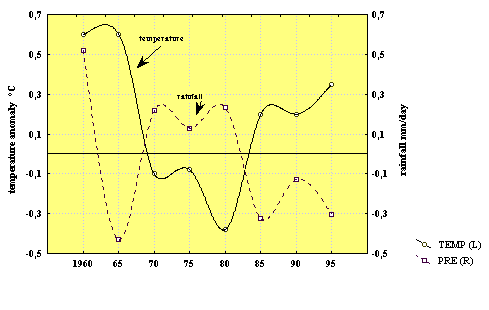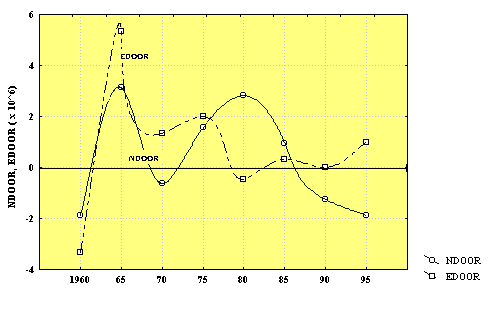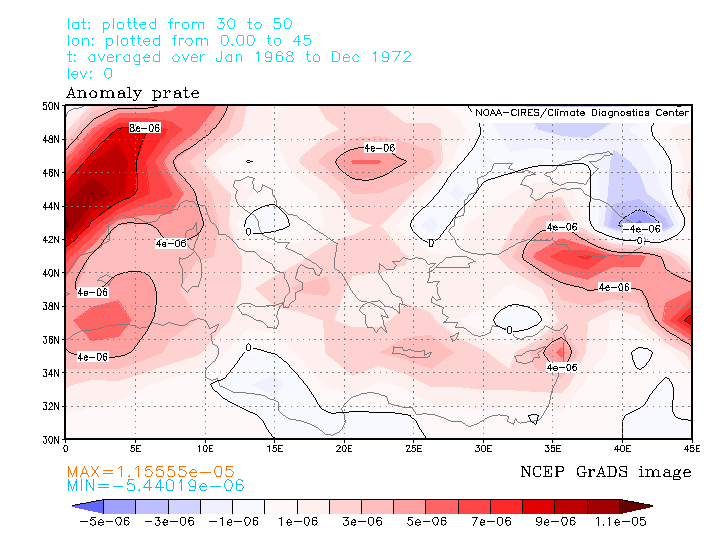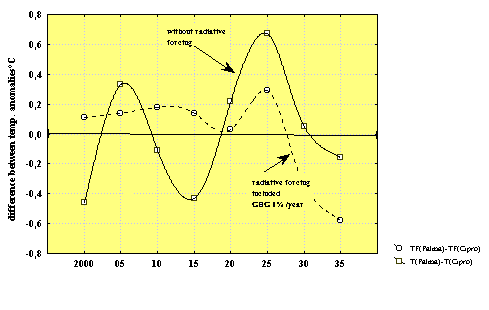
Fig.1. Temperature and rainfall differences between western and eastern parts of the Basin.
SABINO PALMIERI 1, ANNA MARIA SIANI 1, GIUSEPPE R. CASALE 2 , DANIELA MELONI 2
1University "La Sapienza", Dep. of Physics, P.le A.Moro n.2, 00185 Roma, Italia
2Consulting Meteorologist
Abstract
An investigation on Mediterranean climate variations during the last 40 years is carried out. Areas centred at Cagliari and Athens show, in the decade 1978-1987, a constant increase of temperature. A similar time interval characterised by increasing temperature is reported for Palermo between 1973 and 1982. Dramatic temperature rises are experienced in the three areas during 1998-2000. This climate variation is in agreement with the mean temperature change of the northern Hemisphere.
The long period (about 20 years) climate oscillations between western and eastern parts of the Basin, depend very probably on the frequency of cold outbreaks at the opposite ends of the Mediterranean. The frequency unbalance is very likely the cause of the observed fluctuation in the 5-year mean data. The Italian Peninsula, due to its geographical position and to the longitude elongated Appennine Range, acts like a climatic watershed between the two parts of the Basin which go through different forcings.
Climate simulations provided by the Hadley Centre (UK) for the first
half of the present century, show a temperature oscillation (20 year cycle)
generated by the HadCM2 model control run (present climate), supporting
the concept of the " Mediterranean Oscillation" . In the same model run
including greenhouse forcing, the oscillation is damped.
1. Introduction
The interest for a frequent update of Mediterranean climate studies is stimulated by two main factors: first of all many activities prevailingly in agriculture, are vital for the economy of coastal populations, while some desertification processes are already visible; second possible climate changes in the framework of a global warming due to greenhouse gases may have serious implications for this area.
General circulation models (GCM) of the atmosphere have been recently applied to assimilate available observations at a given time with the intent of producing a three dimensional structure of the atmosphere at points of a regular grid. Reanalysis procedures have the great advantage to guarantee homogeneity and physical consistency of all the observations, which are amalgamated by the model physics. Nevertheless some limitations should be stressed: (a) the methodology implies a smoothing of the data: the value of a given atmospheric quantity at a grid point shall be interpreted as an average for an area of about 200 by 200 Km2; (b) while some quantities are strongly conditioned by actual values provided by stations (as is the case of temperature), others are seriously affected by the model parameterizations (for example precipitation); (c) time series derived from reanalysis products may be considered perfectly homogeneous solely in areas where the observing system remained appreciably constant in time (radiosonde network in particular).
Mediterranean climate, with special attention to the latitude of 40° N, was revisited making use of reanalysis data provided by NCEP/NCAR (Kalnay et al, 1996, Kistler et al, 2001) made available for a time span of 40 years.
In this study, three areas of the Mediterranean basin are considered in the sense previously described in (a) indicated by the names of major towns in their respective centres: Cagliari (Sardinia), Palermo (Sicily), Athens. The analysis of Mediterranean oscillation is also based on data from Palma (Majorca) and Cyprus. Each of the considered areas includes an upper-air station which has been operating without a break during the last forty years.
The temperature and precipitation anomalies for the last four decades, utilised in the present work are generally referred to contiguous five year blocks, without any form of smoothing or any spurious regularity applied to the data. A three year interval was considered for 1998 — 2000, although temperature variations are always expressed in °C / 5year for the sake of comparison with the other periods.
After a first part devoted to the description of low frequency fluctuations of Mediterranean climate, to their possible relationship with the NAO Index (North Atlantic Oscillation Index) and to the analysis of differences between western and eastern sections of the Basin, a comparison is offered between climate fluctuations perspectives derived from the HadCM2 model (Hadley Centre,UK) both in the case of greenhouse gases forcing present or absent.
2. Outline of Mediterranean climate behaviour in the period 1958-2000
Making reference to tables 1,2,3, it may be noted that in the three
considered areas a nearly coinciding period of definite temperature increase
is present (1978-87 for Cagliari and Athens, and 1973-82 for Palermo).
A more marked temperature rise occurred in 1998-2000. This in agreement
with the general temperature behaviour in the northern Hemisphere (Jones
et al., 1997).
| Area | Period | temperature | rainfall |
| Cagliari | 1958-1977 | -0.10 °C/ 5 years | No change |
| " | 1978-1987 | +0.33 °C/ 5years | -0,20 mm/day |
| " | 1988-1992 | No change | -0,20 mm/day |
| " | 1993-1997 | +0.12 °C/ 5years | No change |
| " | 1998-2000 | +0.96 °C/ 5 years | -0.27 mm/day |
Table 1. Climate fluctuations (temperature and precipitation)
in the period 1958-1997 in an area 200x200 Km2 centred on Cagliari.
For 1998 — 2000, temperature variations are also expressed in °C /
5year to allow comparison with the other periods.
| Area | Period | temperature | rainfall |
| Palermo | 1958-1967 | +0.10 °C / 5years | No change |
| " | 1968-1972 | -0.18 °C / 5years | -0.10 mm/day |
| " | 1973-1982 | +0.33 °C / 5years | -0.20 mm/day |
| " | 1983-1987 | No change | -0.10 mm/day |
| " | 1988-1997 | +0.04 °C / 5years | +0.10 mm/day |
| " | 1998-2000 | +0.83 °C/ 5years | -0.24 mm/day |
Table 2. Climate fluctuations (temperature and precipitation)
in the period 1958-1997 in an area 200x200 Km2 centred on Palermo.For
1998 — 2000, temperature variations are also expressed in °C / 5year
to allow comparison with the other periods.
| Area | period | temperature | rainfall |
| Athens | 1958-1967 | -0.22 °C / 5years | No change |
| " | 1968-1972 | +0.35 °C / 5years | -0.30 mm/day |
| " | 1973-1977 | -1.30 °C / 5years | No change |
| " | 1978-1987 | +0.27 °C / 5years | -0.40 mm/day |
| " | 1988-1997 | -0.07 °C / 5years | +0.20 mm/day |
| " | 1998-2000 | +0.83 °C/ 5years | +0.26 mm/day |
Table 3. Climate fluctuations (temperature and precipitation) in the period 1958-1997 in an area 200x200 Km2 centred on Athens. For 1998 — 2000, temperature variations are also expressed in °C / 5year to allow comparison with the other periods.
One of the time intervals characterised by increasing temperatures at Athens (1978-87) was coupled to an appreciable decrease of rainfall. A similar situation occurred during the shorter warming period 1968-72 with obvious implications for the aridity which is in general a more serious problem in the eastern Mediterranean (Palmieri, 1998). Luckily in the recent interval 1998-2000, the dramatic temperature increase in Athens area was associated to an increase in rainfall. On the other hand, in the same years, aridity becomes a critical issue for southern Sardinia and western Sicily due to the coupling of a marked temperature rise with an appreciable rainfall decrease.
3. Low frequency climate fluctuations
An analysis of the difference between temperature and rainfall anomalies (reference climatology 1979-1995) at the two opposite ends of the Basin shows interesting features (Fig.1):
The out of phase time behaviour of temperature and rainfall is evident;
a main fluctuation stands out characterised by higher temperatures (lower rainfall) in the western portion of the Basin in the 1960-70 decade; on the other hand the situation is reversed in the 1970-80 decade and warmer conditions together with lower rainfall are experienced in the eastern part of the Mediterranean. In the 1985-95 decade the pattern present in 1960-70 is reappearing.
In reference to (a), as noted by other authors (Palmieri et al. 1991; Issar
et al., 1998; Vaccaro, 1998), the out of phase behaviour of temperature
and rainfall patterns is a well defined feature present in the time series
of the instrumental period and the appearance of a similar feature in the
reanalysis data supports the consistency between the model and the observational
data.

Fig.1. Temperature and rainfall differences between western and eastern
parts of the Basin.
The possible existence of a "Mediterranean Oscillation" (OM) was proposed by the Italian climatologist M.Conte (Palutikof et al, 1996) in a study of the time behaviour of the 500 hPa height at the stations of Algiers and Cairo. The name was inspired by well known examples such as the "Southern Oscillation" (SO) and the "North Atlantic Oscillation" (NAO). The SO consists in a intensity trade wind variation in the tropical belt of the Pacific Ocean, while the NAO is a fluctuation in the intensity of westerlies in the Northern Atlantic Basin. In both cases time periods involved are sufficiently short to support, with several alternating cycles, the existence of a real oscillation. The Mediterranean oscillation on the other hand, having a period of about 20 years, would require very long time series of data to be assessed.
In order to move a first step in identifying possible forcings of Mediterranean Basin climate fluctuations some indexes have been considered to characterise the mean large scale circulation patterns. It is assumed that low frequency climate fluctuations may be interpreted by means of a "box" model of the Basin with two main "doors" coinciding with the gaps in the topographic barrier sheltering the Mediterranean from cold air outbreaks.
The NDOOR index, defined as DH1000 hPa/Dn, height gradient of the 1000 hPa surface, along the line connecting the points 42N 00W and 42N 10E, a parameter related to the frequency of cold outbreaks from N or NW entering the Basin either through the Rhone Valley or the Carcasson gap between Pyrenees and French Central Massif.
The EDOOR index, defined as DH1000 hPa/Dn, height gradient of the 1000 hPa surface, along the line connecting the points 45N 25E and 36N 35E, a parameter related to the frequency of cold outbreaks from N E entering the Basin through the north eastern gap (Black Sea, Aegean Sea).
The NAO index, well known and frequently used, defined as the difference of atmospheric pressure between Azores and Island, representing the intensity of westerlies in the North Atlantic area (Hurrel, 1995; Jones et al., 1997).
The five year period 1963-67, centred in 1965, corresponds to a time interval in which the world climate (including Mediterranean) was experiencing a temporary cooling trend. It may be noted that EDOOR contribution was quite large and dominating in this period (high frequency/intensity of cold outbreaks from NE in the eastern portion of the Basin). After 1967 EDOOR values gradually decreased characterising the warming trend setting in. Around 1980 NDOOR shows a second peak corresponding to a colder climate in the western part of Mediterranean.

Fig.2. NDOOR and EDOOR behaviour.
The peculiar feature of the next decade (marked warming trend) is the very low frequency of cold advection episodes, both from N (western portion of Basin) and from E-NE (north eastern region of Mediterranean).
Examples of the relationship between Mediterranean rainfall and the
North Atlantic oscillation is shown in Fig.3. The period 1988-92 is characterised
by particularly active North Atlantic westerlies ( mean NAO index = +0.36).
It may be seen (lower map) how rainfall anomalies are negative in whole
Mediterranean Sea with marked areas over eastern Balkan Peninsula, Ionian
Sea and western portion of the Basin. The consideration of southern Appennines
as a climatic watershed in a warming scenario is supported by the strong
anomaly gradient across this mountain range. On the other hand a typical
period of low NAO index (mean 5 years value equal to — 0.15) is 1968-72.
In this case (Fig.3, upper map), the anomaly pattern is reversed in sign
(positive values dominate).


Fig.3. Rainfall anomalies for two typical periods
characterised by low (upper map) and high (lower map) values
of NAO Index. Units are Kg/m^2 s. To obtain mm/day multiply by 86400. Reference
climatology 1979-1995.
4. Mediterranean climate changes in simulation exercises
Climate simulations obtained by the HadCM2 model (Johns et al.,1997) are considered (period 1995-2035) with the intent of investigating climate oscillations in the Mediterranean Basin resulting from the model output, either with or without inclusion of the radiative forcing due to greenhouse gases.

Fig.4. Temperature anomalies resulting from HadCM2 model: differences
between western and eastern Mediterranean.
Results shown in Fig.4 indicate that the model run without radiative forcing generates alternating cycles of climate in the western and eastern portion of the Basin with a period of about 20 years. When radiative forcing is included, assuming an increase of greenhouse gases of 1% per year, the fluctuation nearly dies out supporting the view that, in a warming scenario, the frequency of cold outbreaks into the basin, main cause of uneven climate behaviour within the Basin, is decreasing. Obviously this is only a preliminary investigation to be confirmed by a more extended analysis.
5. Conclusions
In the three considered areas a nearly coinciding period of definite temperature increase is present (1978-87 for Cagliari and Athens, and 1973-82 for Palermo). A more marked temperature rise occurred in 1998-2000. This in agreement with the general temperature behaviour in the northern Hemisphere. The time interval characterised by increasing temperatures at Athens (1978-87) was coupled to a decrease of rainfall. A similar behaviour occurred during the shorter warming period 1968-72 with obvious implications for the aridity which is in general a more serious problem in the eastern Mediterranean. Luckily in the recent interval 1998-2000, the dramatic temperature increase in Athens area was associated to an increase in rainfall. On the other hand, in the same years, aridity becomes a critical issue for southern Sardinia and western Sicily, due to the simultaneous temperature rise and decrease of rainfall.
Low frequency climate fluctuations may be interpreted by means of a "box" model of the Basin with two main "doors" coinciding with the gaps in the topographic barrier sheltering the Mediterranean from cold air outbreaks. The unbalance in the frequency of cold advection episodes in the Western and Eastern portions of the Basin is very likely the cause of the so called "Mediterranean Oscillation". A reliable assessment of a cycle of about 20 years would require a much longer series of historical data.
In a period of definite warming trend (1988-1992) NAO index is coupled with negative rainfall anomalies over an extended portion of the eastern Mediterranean with a negative ridge extending over Greece and Ionian Sea. The consideration of the Italian southern Appennines as a "climatic watershed" is supported by the strong anomaly gradient across this mountain range. On the other hand, in a typical period of low NAO index, such as 1968-72, the anomaly pattern is reversed in sign.
Climate simulations obtained by the HadCM2 model indicate that the model run without radiative forcing generates alternating cycles of climate in the western and eastern portion of the Basin with a period of about 20 years. When radiative forcing is included, the fluctuation nearly disappears supporting the view that, in a warming scenario, the frequency unbalance of cold outbreaks, main cause of uneven climate behaviour within the Basin, is decreasing.
Acknowledgments: the present work was realised in the framework of the Italian CNR Coordinated Project "Reconstruction of Mediterranean Climate"; Contract n. 9800176.CT02.
The authors are grateful to the Climate Diagnostic Center (USA) for
providing reanalysis data. Thanks to the Hadley Centre (UK Met Office)
for the climate simulation data.
References
Hurrel J.W.,1995, Decadal trends in the North Atlantic oscillation and relationship to regional temperature and precipitation, "Science", 269: 676-679.
Issar A. S., Brown N.,1998, Water, Environment and Society in Times of Climatic Change, Chapter 11, Walter Dragoni, 241-271, Kluver Academic Publishers, printed in Netherlands.
Johns T. C., Carmenll R.E., Crossley J.F., Gregory J.M., Mitchell J.F.B., Senior C.A., Tett S.F.B., Wood R.A.,1997, The second Hdley Centre coupled ocean atmosphere GCM: model description, spin up and validation, "Climate Dynamics", 13, 103-134.
Jones P.D., Jonsson T., Wheeler D.,1997, Extension using early instrumental pressure observations from Gibraltar and SW Iceland to the North Atlantic Oscillation, "Int. J. Climatology", 17 : 1433-1450.
Jones P.D. , New M., Parker D.E., Martin S., Rigor I.G., 1999, Surface air temperature and its changes over the past 150 years, "Rev. Geophys.", 37, 173-199.
Kalnay E. and Co-authors, 1996, The NCEP-NCAR 40 year reanalysis project, "Bull.Amer.Meteor. Soc.", 77, 437-471.
Kistler R. and Co-authors, 2001, The NCEP-NCAR 50- YearReanalysis, , "Bull.Amer.Meteor. Soc.", 82, 247-267
Palmieri S., 1998, Global warming clues in the Mediterranean Region: impact study on flooding risk; Proceedings of the " International Conference on the impacts of climate change in the Mediterranean Countries"; Metsovo, Greece, Sept. 1998.
Palmieri S., Siani A.M., D'Agostino A., 1991, Climate fluctuations and trends in Italy within the last hundred years, Ann. Geophysicae,9,769-776 , (Berlin, Germany).
Palutikof J.P., Conte M., Casimiro Mendes J., Goodes C.M., Espirito Santo F., 1996, Mediterranean Desertification and Land Use, Chapter 4, "Climate and Climatic Change", John Wiley & Sons, Ltd.
Vaccaro L., 1998, Caratteristiche evolutive del clima del bacino del Mediterraneo, Univ. of Rome "La Sapienza" , Dep. of Physics, Physics, Doc. degree thesis.